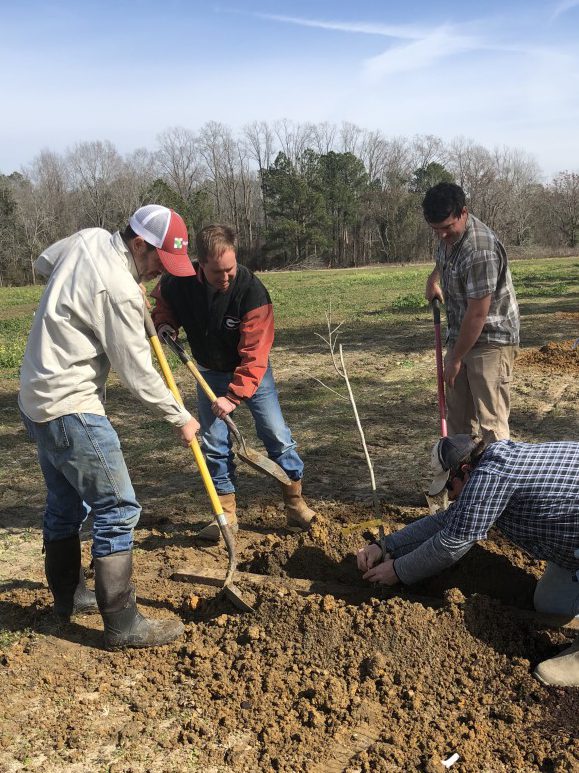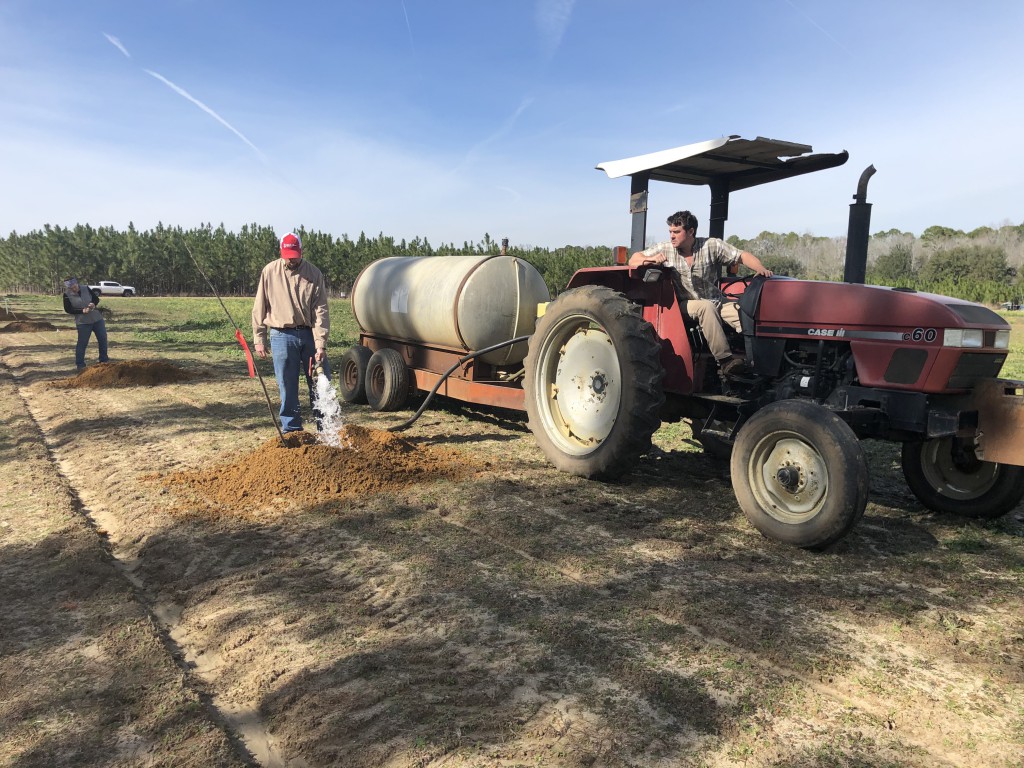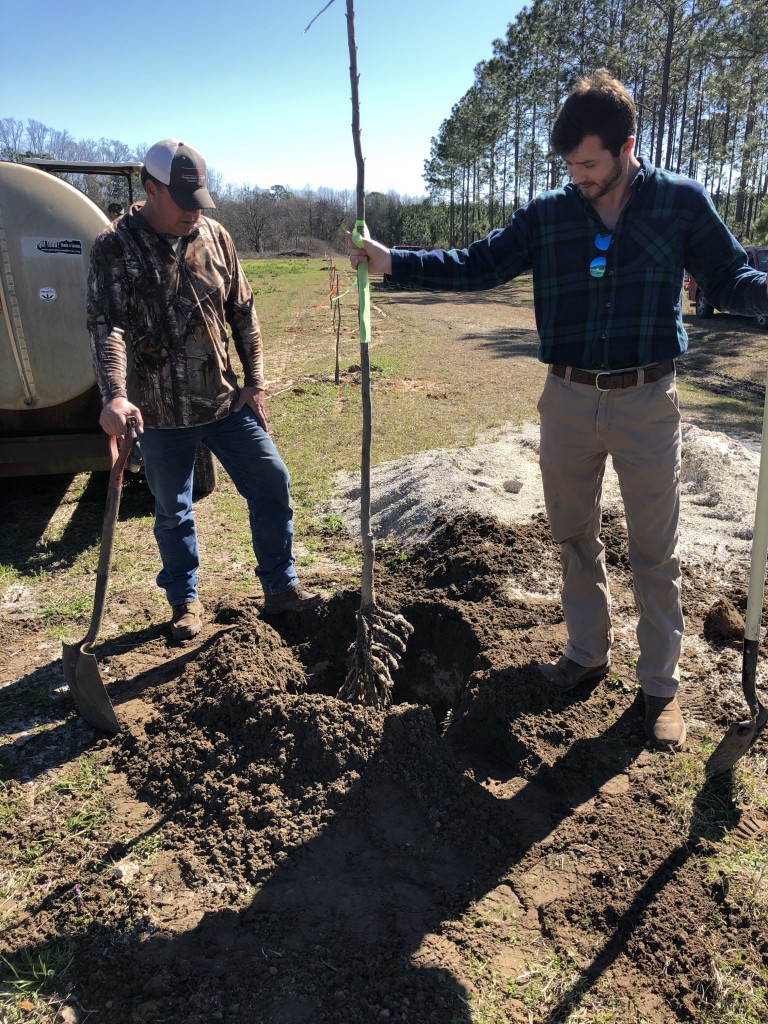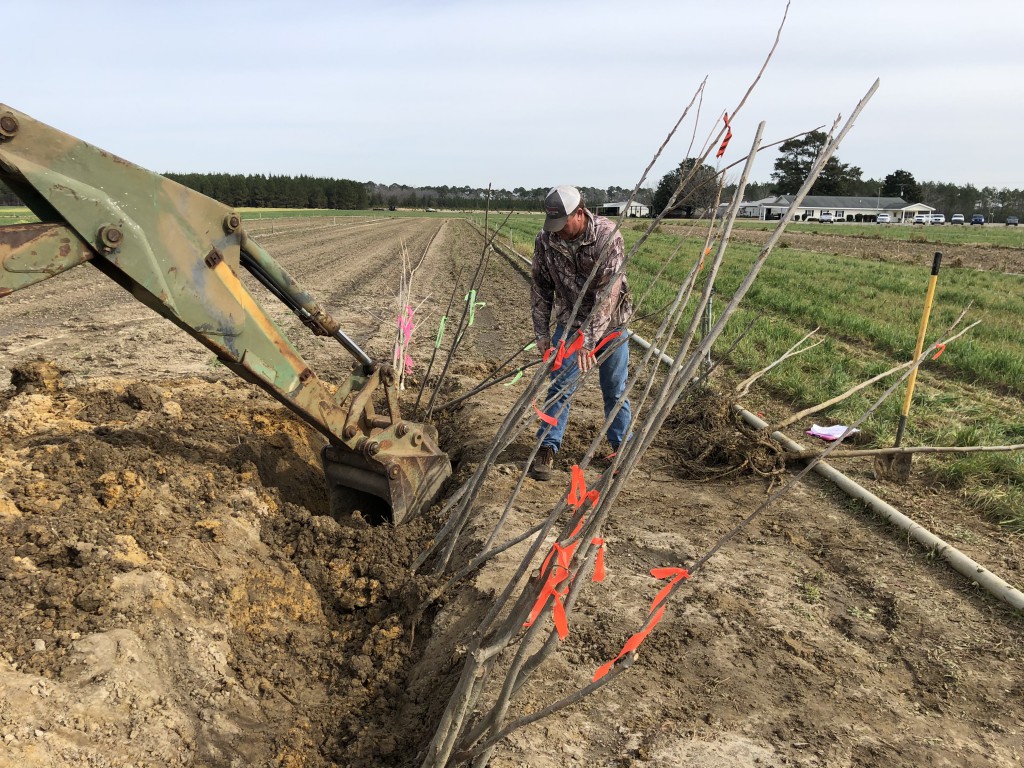Written By: Emily Cabrera, IPM Communications Coordinator
Expert Source: Andrew Sawyer, Southeast District Area Pecan Agent

After a year of thoughtful planning and collaboration, young pecan trees have finally been planted in what will serve as both long-term research plots and short-term demonstration plots at the University of Georgia Vidalia Onion and Vegetable Research Center in Toombs County.
Research will focus on low-input pecan varieties that can successfully grow in Georgia without incidence of pecan scab fungus (Fusicladium effusum) – the most detrimental disease of pecans in Georgia. Plots will also be utilized for hosting field days for agents and growers to observe best management practices during these critical establishment years where decisions can have significant and long-lasting effects on growth and yield.
Andrew Sawyer is the Southeast District Area Pecan Agent, whose position is supported by the Georgia Pecan Grower’s Association and UGA Extension. He initiated this multi-faceted project last year from a grant provided by the Georgia Pecan Commission to meet the research demand of pecan production in the state as Georgia currently leads the nation in pecan production, adding between $200 to $300 million to the state’s gross domestic product each year.
Eager for collaboration, Sawyer built a team of specialists, county Extension agents, local growers and growers association representatives to make sure everyone had a hand in the process. “This is the essence of true Extension work,” he said of the team effort that helped get over 140 pecan trees planted in February of this year.
The team planted a mixture of low-input cultivars including McMillan, Lakota, Avalon, Excel, Eclipse and Kanza. An older variety, called Sumner, was also planted to be used as a comparison due to its susceptibility to pecan scab fungus and popularity among growers in Southeast Georgia. Many seedling trees were also planted which will be grafted with newer varieties a few years from now.
Demonstration plots will be used for hosting field days within the next year as most of the critical management decisions in pecans are made within the first few years of planting. Sawyer and the team will highlight differing fertilizer, pruning, irrigation and spacing regiments and their potential impact on growth and yield. “Pruning is a very important cultural practice that is easier to demonstrate than discuss,” explained Sawyer, “so this site will be good for demonstrating the right way to prune pecans within their first four years.”
Another essential part of managing an orchard is implementing the right fertility program without breaking the bank. “Low input is always the goal,” said Sawyer. “We are planting a lot of new pecan trees in Georgia, so anything that helps reduce our loss of newly planted trees or gets them producing faster while also reducing inputs is highly desirable.”
To test this, Sawyer is experimenting with several fertility methods and comparing them to current UGA fertilizer programs.

Next up, the team will be working with Dr. Gary Hawkins, his graduate student, and the Department of Engineering to install a variation of moisture sensors. On a site visit to Oconee County last year, Sawyer, Hawkins and county agent Monte Stephens observed pecans planted in clay soils, which lead to designing a research project for investigating the effects of different irrigation rates for various soil types in Georgia.
“Much of the pecan irrigation research has been conducted on sandy loam soils, which is where most of our trees are planted throughout South Georgia, but now that pecans are moving into the Piedmont where soils have higher clay content, we may find that lower irrigation rates can still satisfy kernel development,” Sawyer explained.

Finally, Sawyer and his team will deploy an assortment of herbicide treatments throughout the orchard. With only a handful of preemergent herbicides labeled for use in pecans, the team will use different products and combinations to demonstrate the effect of the various chemistries and the differences in application timing and rates with hopes of equipping agents and growers with the information they need to make better pesticide management decisions respective of the cultivars within their own orchards.

“The most exciting part of this effort is that everyone has a seat at the table. Because the purpose of this work is to benefit all of our stakeholders, getting them involved from the beginning was important to me. Hopefully their involvement will pave the way for continued partnership that will benefit this generation and the next – those who will be tending to these trees long after we’re gone,” explained Sawyer of this collaborative project.
Learn more about pecan management from the UGA Pecan blog https://site.extension.uga.edu/pecan/ and website https://pecans.uga.edu/.
Tune into Sawyer’s pecan radio program at https://soundcloud.com/andrewsawyer-2.

